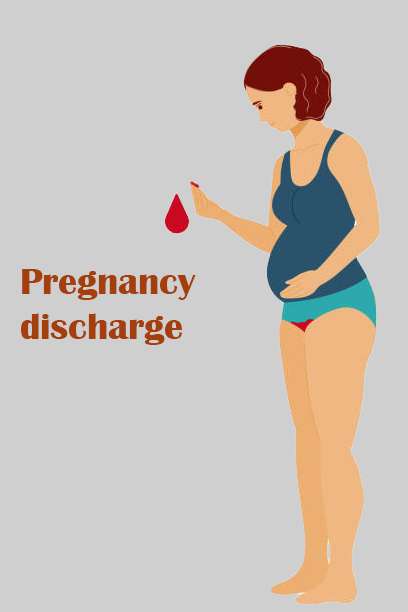Pregnancy discharge:
Pregnancy is a joyful journey full with expectation and enthusiasm. It does, however, come with its fair share of new experiences and questions. Pregnancy discharge is a common source of anxiety among pregnant women. It is critical to note that vaginal discharge during pregnancy is completely normal and might vary in substance and color throughout the pregnancy. In this post, we will go over the specifics of pregnancy discharge, including its origins, what to expect, and when to seek medical attention.
Awareness of Normal Pregnancy discharge:
Several hormonal changes occur in the body during pregnancy, which impact the vaginal environment. As a result, increased vaginal discharge is frequent and usually not reason for worry. It is critical to distinguish between normal discharge and any symptoms of infection or problems. Here are some crucial items to remember:
Consistency:
Typical pregnancy discharge is thin and milky in texture. It may have the viscosity of a light lotion or be somewhat sticky. However, each woman’s experience will differ significantly, and some will notice stronger or thinner discharge.
Color:
Pregnancy discharge can range in color from clear to slightly yellowish or off-white. It is critical to note that any unexpected changes in hue, such as greenish or grey, should be examined with a healthcare physician as soon as possible.
Odor:
Normal pregnancy discharge should be odorless or have a faintly pleasant fragrance. A foul-smelling discharge may suggest an infection and should be checked by a doctor.
Causes of pregnancy discharge:
Understanding the most prevalent reasons of pregnancy discharge can help to allay fears and bring confidence. Here are some of the factors that influence vaginal discharge during pregnancy:
Elevated Estrogen Levels:
Estrogen levels rise dramatically during pregnancy discharge, resulting in increased blood flow and changes in cervical mucus production. This increased mucus production might result in more vaginal discharge.
Leukorrhea:
Normal pregnancy discharge is sometimes referred to as “leukorrhea.” Leukorrhea is the increased production of cervical mucus, which aids in the prevention of infections in the uterus. This discharge is frequently more visible during the second and third trimesters.
PH Balance Changes:
The normal pH balance of the vagina might be affected by the hormonal swings of pregnancy. As a result, the acidity or alkalinity of vaginal pregnancy discharge may vary. This is normally normal, however it can occasionally cause slight discomfort.
When to seek medical advice:
While pregnancy discharge is normally innocuous, any atypical changes that may signal an underlying problem should be noted. Here are some examples of when getting medical help is advised:
Change in Color or smell:
If you detect a rapid change in the color or smell of your discharge, contact your healthcare professional immediately. Unusual colors or bad scents may indicate infection or other issues.
Irritation or itching:
Excessive itching or discomfort, together with unusual discharge, may indicate a yeast infection or another sort of infection. Seeking medical guidance can aid in the diagnosis and treatment of the problem.
Blood streaked Discharge:
If you see any pink or crimson spotting or blood-streaked discharge throughout your pregnancy, you should call your doctor right once. While it may not usually signal a major issue, it is critical to rule out any potential difficulties or hazards.
What does pregnancy discharge look like?
Due to hormonal shifts and increased blood flow to the pelvic area, pregnancy can cause changes in vaginal discharge. The appearance of vaginal discharge during pregnancy might vary, but the following are some common features:
- Increased Volume: Many pregnant women feel an increase in vaginal discharge. This is natural and caused by hormonal changes.
- Color: During pregnancy, vaginal discharge is usually clear or white. It may also have a milky look.
- Pregnancy discharge is often thin and watery, but it can also be thicker or mucus-like. You may notice an increase in cervical mucus as your pregnancy progresses, which can appear thicker and more like egg whites.
- Normal pregnant discharge should not have an unpleasant or foul odor. If you smell a strong or bad odor, it could be an indication of infection, and you should consult your doctor.
- Some women may notice little particles of mucus in their discharge, known as a “mucus plug.” During pregnancy, the mucus plug seals the cervix and protects the uterus. Loss of the mucus plug is a common aspect of the late stages of pregnancy and can be a sign that labor is on its way, but it does not always signal labor is close.
- It’s critical to distinguish between typical pregnant discharge and abnormal discharge that could suggest an illness. If you observe any of the following worrying indications in your vaginal discharge while pregnant, call your healthcare professional immediately:
- Strong or foul odor
- Green or yellow discharge
- The discharge is grayish.
- Itching or burning in the vaginal area
- There is blood in the discharge.
- Any of these symptoms could indicate an infection or another medical problem that requires care. Your healthcare professional can conduct an examination and tests to discover the cause and, if necessary, provide appropriate therapy.
Early pregnancy discharge:
Many women experience a range of symptoms during early pregnancy, which may be both thrilling and perplexing. Vaginal discharge is a frequent symptom that often raises anxiety. In this post, we will look at the many forms of discharge that women may experience during early pregnancy discharge and what they can mean. Understanding these signs might help expecting moms navigate this crucial period in their life more effectively.
Normal Discharge During Early Pregnancy:
It is very typical for women to observe changes in their vaginal discharge throughout the early stages of pregnancy. These alterations are commonly caused by hormonal changes and increased blood flow to the pelvic region. The following forms of discharge are considered typical during early pregnancy:
Milky white discharge:
Milky white discharge is a frequent and odorless form of discharge. It is frequently characterized as having the viscosity of lotion. It is important to realize that discharge differs from person to person, therefore these descriptions are only recommendations.
Increased discharge:
During early pregnancy, many women may notice an increase in the amount of discharge. This is a common occurrence that is frequently ascribed to the body preparing for the changes that occur during pregnancy.
Thin, watery discharge:
During the first few weeks of pregnancy, some women may have a thin, watery discharge. This discharge is normally clear or somewhat whitish in color and does not have a strong odor.
Abnormal Discharge During Early Pregnancy:
While most changes in vaginal discharge are considered typical during early pregnancy, it is critical to be aware of any odd signs that may suggest a problem. Here are a few examples of discharges that may require more investigation:
Yellow or green discharge:
If your vaginal discharge turns yellow or green, it might be an indication of an infection. This might be caused by a number of circumstances, including a sexually transmitted illness or a urinary tract infection. If this sort of discharge is noticed, it is critical to visit a healthcare expert.
Gray discharge:
A grey pregnancy discharge, especially if it is accompanied by a strong fishy odor, may suggest bacterial vaginosis. This is an infection caused by a bacterial imbalance in the vagina. If this sort of discharge is observed, prompt medical intervention is required.
Thick and cottage cheese-like:
This sort of pregnancy discharge, which is frequently accompanied by itching and discomfort, might indicate a yeast infection. Yeast infections are prevalent during pregnancy and are readily cured with the help of a medical professional.
Creamy white early pregnancy discharge:
Creamy white discharge is common in early pregnancy and is frequently ascribed to hormonal changes and increased blood flow to the pelvic area. During pregnancy, many women experience changes in vaginal discharge. Here’s everything you need to know about early pregnancy creamy white discharge:
- Creamy white discharge is one of the first indications of pregnancy and can appear as early as a few days after conception. It can last the entire pregnancy.
- Color and consistency: Typically, this type of discharge is thick, milky, and white in color. It has the appearance of a creamy lotion or may be slightly hazy.
- Normal pregnant discharge is typically odorless. If you smell a foul or unpleasant odor, this could be an indication of an infection, and you should contact your healthcare professional.
- While some vaginal discharge is typical during pregnancy, it should not be excessive or cause pain. If you notice a large increase in discharge or if it becomes unpleasant, speak with your healthcare physician.
- Itching or Irritation in the Vaginal Area: If the discharge is accompanied with itching, irritation, or pain in the vaginal area, it could be an indication of a vaginal infection. You should seek medical attention in such circumstances.
Implantation early pregnancy discharge:
Implantation bleeding is frequent in early pregnancy and might be mistaken for a light menstruation or cause changes in vaginal discharge. Here are some important information concerning implantation bleeding and discharge:
- Timing: Implantation bleeding usually occurs 6-12 days after fertilization, around the time the embryo attaches itself to the uterine lining. This usually occurs before a missed menstruation.
- Appearance: Implantation bleeding is usually light in color and can be pink, brown, or even red. It is much lighter than a regular menstrual cycle and does not usually necessitate the use of pads or tampons.
- Duration: Implantation bleeding is often brief, lasting between a few hours to a few days at most. If the bleeding lasts for an extended amount of time or is excessive, it’s crucial to see a doctor because it could be an indication of something worse.
- Associated Symptoms: Some women may suffer minor cramping in conjunction with implantation bleeding, but it is rarely as severe as menstruation cramps.
- Vaginal discharge might also be affected by implantation hemorrhage. It may cause a brief increase in vaginal discharge that is reddish or brownish in color. This is due to the mixing of implantation blood with regular cervical mucus.
Conclusion:
Understanding the changes that occur in pregnancy discharge can offer pregnant moms with much-needed confidence. While typical discharge may vary in consistency, color, and fragrance, it is critical to be on the lookout for any odd symptoms that may necessitate medical care. Women may handle their pregnancies with confidence and peace of mind if they know what to anticipate and when to seek expert guidance. Accepting the wonderful adventure of pregnancy entails accepting changes in our bodies, including the totally natural phenomena of pregnancy discharge.






Pingback: Vaginal Itching - Journey Of Mother